 | In 1912, Maine State DAR erected granite monuments on Indian Island, Old Town, and Pleasant Point at Perry, to honor Passamaquoddy and Penobscot Indians who served in the Revolutionary War. | Originally placed by Col Asa Whitcomb Chapter in 1924, Colonial Daughters has re-dedicated this monument to Elizabeth Dyar, Daughter of Revolutionary War Patriot John Nichols. | 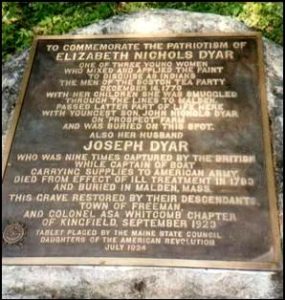 |
 | Maine State DAR placed a plaque on the home of General William Whipple, signer of the Declaration of Independence, in 1913, in Kittery. In 2018, a rededication was held with many of Whipple descendants in attendance. | in 1976, Esther Eayres members placed a boulder with a marker in front of the Post Office, in Orono. This commemorates the Revolutionary War Patriots who lived in Orono. | 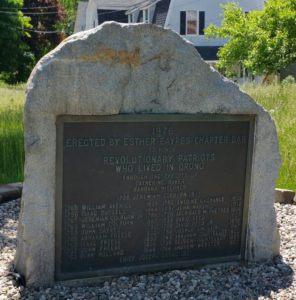 |
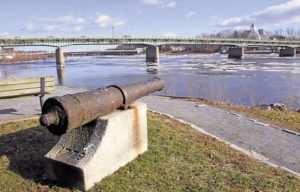 | Cannon from an American ship scuttled, to save it from being taken by the British, in the Penobscot River during the Penobscot Expedition in 1779. The cannon was discovered at the bottom of the river when it was dredged for the new Joshua Chamberlain Bridge. A brass plate was attached to the cannon in Brewer in 1957 by the Brewer Junior American Citizens Club of the Frances Dighton Williams Chapter NSDAR. | Frances Dighton William Chapter NSDAR placed a boulder with a plaque in 1977, marking the spot of the first sawmill in Bangor, Maine. |  |
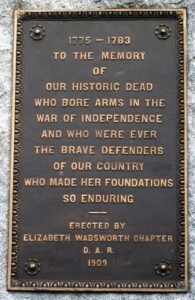 | In 1909, Elizabeth Wadsworth Daughters erected a monument in the historic old Eastern Cemetery, in Portland, to the memory of over one hundred Revolutionary Soldiers who are buried in that vicinity, most of them in unidentified graves." The monument has the following inscription: “1775-1783 To the Memory of Our Historic Dead Who Bore Arms in the War of Independence and Who Were Ever the Brave Defenders of Our Country Who Made Her Foundations So Enduring.” | The site of the First Naval Battle of the American Revolution was marked by the Hannah Weston members in 1927. This marker commemorates the "Battle of the Margaretta." | 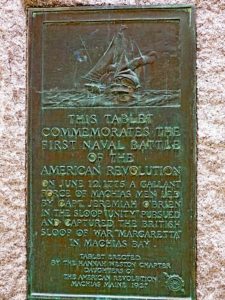  |
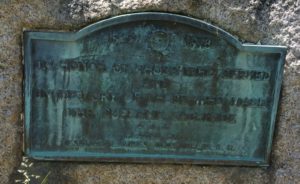 | Esther Eayres members place a plaque which was unveiled on November 11, 1927, to honor World War Veterans of Orono. It was placed on a boulder on the lawn in front of the O.H.M.H. American Legion Post # 84. | In 2014, after viewing the declining conditions at Tolman Cemetery, Lady Knox members launched project to return the oldest cemetery in Rockland, Maine, to a fitting place for the burial of 21 Revolutionary War patriots whose names appeared on a bronze plaque placed at the entrance to the cemetery in 1947 by the Maine State Organization of NSDAR. On September 17, 2017, the new monument and plaques were dedicated. | 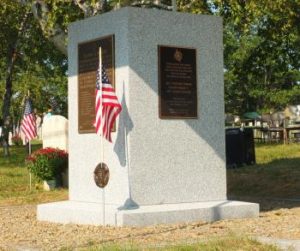 |
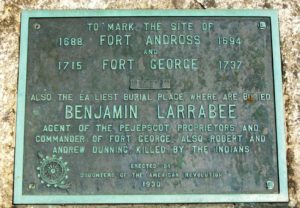 | Maine DAR erected a marker in 1930 in Brunswick, Maine, in Cumberland County. Marker is near the entrance to the Fort Andross Mill Business Center (former textile mill) commemorating Fort Andross and Fort George. | The Old Walpole Meetinghouse, at the head of South Bristol Peninsula, stands today in its original 1772 form, appearing virtually as it did to our forbears. It is one of the three oldest churches in Maine. Pemaquid Chapter NSDAR placed a marker in 1936. The Meetinghouse is listed on the National Register of Historic Places. | 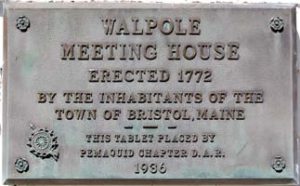 |
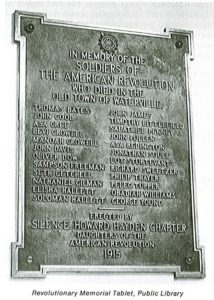 | In 1915, Silence Howard Hayden Daughters placed this marker in the Waterville Library, which is located at 73 Elm Street. “In Memory of the Soldiers of the American Revolution who died in the Old Town of Waterville.” The names of the Patriots follow the inscription. | Real Daughter Salome Sellers died in the same house she and her husband had built in 1830 in Deer Isle, Maine, on January 9, 1909, aged 108 years, 82 days. Her house is now known as the Salome Sellers House and home to the Deer Isle-Stonington Historical Society. She joined the DAR at age 107 in 1907. Mount Desert Isle Daughters placed a plaque in 1989, which was re-dedicated in 2017. |  |
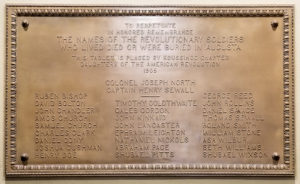 | The Lithgow Library in Augusta, Maine has a plaque donated by the Koussinoc members in 1905. It lists the names of the Revolutionary War Patriots who lived and died in Augusta. | Sewall’s Bridge, built by Major Samuel Sewall in 1761 over the York River, was the first wooden pile drawbridge in North America. Old York Chapter NSDAR placed a commemorative marker at the site in 1932. | 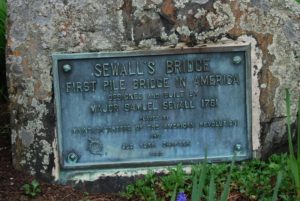 |
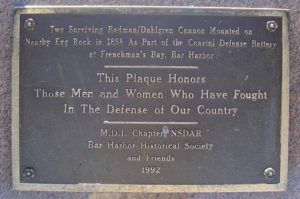 | Mount Desert Isle Chapter NSDAR placed a plaque at the site of Civil War Cannon, Agamont Park, Bar Harbor, Maine, in April 1992. This marker is bolted to a piece of Maine Pink Granite. The battery on Egg Rock Island was a temporary emplacement of two 10-inch smoothbore Rodman cannons, which were abandoned on the island in 1901. In 1991 the Coast Guard and the Connecticut National Guard used a “Sky Crane” helicopter to move the huge guns to shore where they were refurbished, and placed in Agamont Park, where they remain. The dedication was held April 26, 1992. | Richard Vines built a dwelling house in 1616, about one mile from Biddeford Pool at a plot known as Leighton’s Point, which was the beginning of the settlement. In 1912, William E. Barry purchased a part of the tract of land on which the Richard Vines house was built and erected a granite monument with a suitable inscription. In 1931, Mr. Barry approached the Rebecca Emery Chapter NSDAR to request they assume responsibility for the monument, which they have to this day. |  |
 | In October 1961, Tisbury Manor Chapter placed a bronze tablet set in native stone in front of the guide post at the "Moosehorns" in Abbot. The original moose horn was erected about 1817 to mark the divergence of the trail to Monson, from the Abbot to Blanchard (Million Acres) trail, and ever since, moose horns have marked this spot, becoming a familiar landmark. | On October 16, 1967, Pemaquid Chapter NSDAR marked the site where William Jones lived. He was a Colonel in the Revolutionary War, and commanded the 3rd Lincoln County Regiment, which protected that whole area. Colonel William Jones is buried in the Old Walpole Cemetery in Damariscotta. The marker was unveiled by Miss Gill Marie Russell, age 8, an 8th generation descendant of Colonel William Jones. | 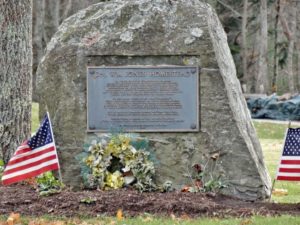 |